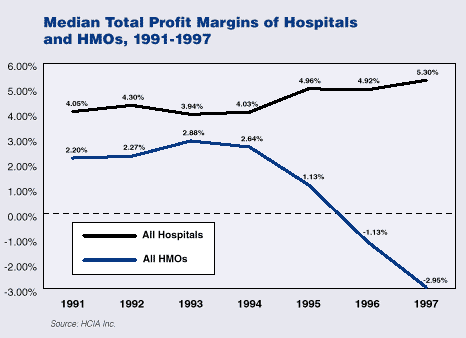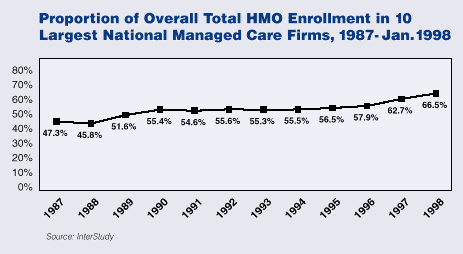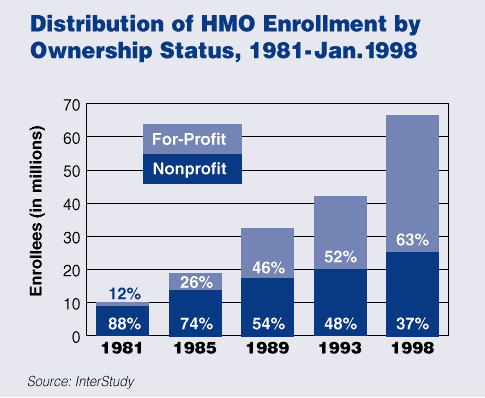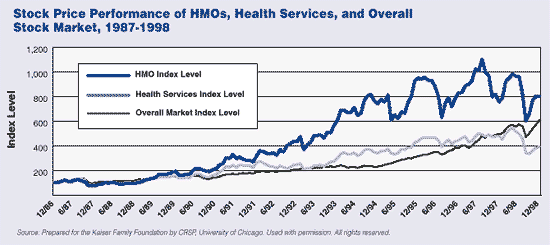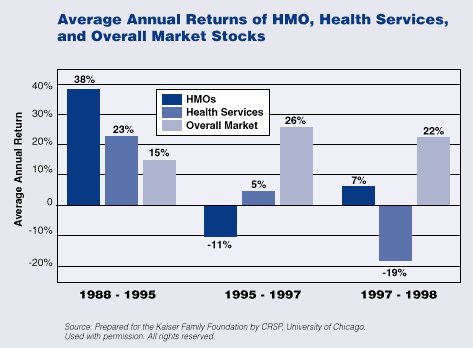Medicare Restructuring: The FEHBP Model
Executive Summary
Part 2
How Well Does FEHBP work?
FEHBP has been somewhat more successful than Medicare in controlling costs. However, recent trends indicate that FEHBP’s competitive structure alone cannot guarantee cost control over the long term.
Until recently, FEHBP experienced slightly lower growth in spending per enrollee than Medicare. Over the period 1987 to 1997, Medicare spending per beneficiary grew at an annual rate of 8.1 percent. FEHBP spending per enrollee grew at 7.1 percent a year over the same period, and at much lower rates in the mid-1990s. In the last two years, FEHBP premiums have increased sharply, by 8.5 percent in 1998 and 10.2 percent in 1999. (At the same time, growth in Medicare per capita spending slowed to almost zero in 1998, and may actually decline in 1999.)
The experience under FEHBP thus parallels that recently reported for private employers, sizable premium increases after a brief period of rate stability. Various causes have been suggested for these increases in the private sector, including the growth of less tightly structured managed care plans or an inability on the part of such plans to control the use of new pharmaceuticals and other medical technologies. An additional factor that may have affected spending growth under FEHBP is that, during the early 1990s, there was a significant shift from the employee organization fee-for-service plans to HMOs. This trend ended by 1995. While enrollment in the employee organization plans has continued to drop, the enrollees have been moving to Blue Cross/Blue Shield rather than to HMOs.
Whatever the reason for the recent increases, it is clear that FEHBP’s favorable experience in the mid-1990s is not necessarily an indicator of its likely success in controlling costs in the future. Nothing in the FEHBP structure guarantees control over costs in the long term. While FEHBP might be described as a “premium support” system, it is not a defined contribution program. There is no budgetary limit on the growth in government contributions to FEHBP plans; instead these contributions are tied to the rates established for different plans and the choices made by participants. OPM has some degree of flexibility in negotiating benefits and rates with the plans, but it does so under political constraints.
For example, OPM did not respond to the prospect of an 11.6 percent increase in Blue Cross/Blue Shield rates for 1999 by requiring a significant reduction in benefits. If OPM had sought to restrain growth to, say, 5 percent, the necessary benefit changes would presumably have led to an outcry from employees, unions, and retiree groups. It is likely that HCFA (or any alternative administrative entity) would face even greater resistance if it attempted to meet a vague goal of fiscal restraint by negotiating benefit reductions: benefit changes would affect not only millions of beneficiaries but a health care industry heavily dependent on Medicare payment. As a result, substantive benefit changes would probably continue to be made through the political process.
The FEHBP program is heavily affected by biased selection, the concentration of more costly enrollees in certain plans. This has distorted price competition and penalized higher-risk enrollees, and may have increased government costs.
The 1998 biweekly premiums charged by FEHBP plans to single enrollees range from $41 to $174, a difference of 321 percent. Part of this variation is geographic: the lowest-cost plan is a local HMO in Florida, the highest cost plan a national employee association plan. Even within a geographic area, however, rates vary enormously: in the Washington, D.C. area, the most costly plan charged 2.6 times as much as the least costly. This difference is not related to the benefits offered by the plans-on the contrary, the least generous plans have the highest premiums. Instead, FEHBP premiums appear to be determined largely by the characteristics of the populations they enroll, rather than by their benefits, reimbursement rates, or efficiency in delivering services. Older and sicker participants are heavily concentrated in certain plans. These plans must charge more than the plans with lower-risk enrollees, and the excess cost is passed on directly to the participants.
Why is selection a problem? First, the government may be overpaying the HMOs. The HMO premiums are based on their charges to commercial enrollees and are not necessarily adjusted for characteristics of the FEHBP participants. If the plans are enrolling healthier FEHBP participants, they-or their capitated subcontractors-may be profiting disproportionately from the FEHBP group. This is especially likely because other participating employers may no longer offer a choice of HMO and fee-for-service options, a practice which has long been thought to encourage favorable selection in HMOs. If other groups are now more heterogeneous, including both healthy and sick enrollees, their rates may be inappropriately high for an FEHBP group biased toward healthier enrollees.
Second, and more important, the price differences that FEHBP enrollees see when they are selecting a plan may not reflect differences in benefits, quality, or efficiency-the factors on which plans should ideally be competing. Instead, some plans appear more costly than others because of the populations they have attracted.
Would an FEHBP-Like System Be Better for Medicare?
Proponents of an FEHBP-like system contend that it would make beneficiaries more sensitive to the costs of the different health plan options available to them. would induce them to choose more efficient plans, and would thus reduce the rate of growth in Medicare spending.
Under the current Medicare+CHOICE system, the government pays the full cost for original Medicare; for enrollees in competing health plans the government contributes an amount roughly equal to the cost of original Medicare for comparable beneficiaries. Beneficiaries who choose original Medicare pay the part B premium. Those who choose less costly plans may receive some free or low-cost supplemental benefits, but never pay less than they would for original Medicare; they still pay at least the part B premium.
Under an FEHBP model, the government contribution would be based on the average price of competing plans, including original Medicare. Enrollees who choose less costly plans would share in the savings. Depending on how the program was structured, this could mean that enrollees who remained in original Medicare would pay more than they do now, while enrollees who shifted to less costly plans would pay less.
Potential for Savings
Would adoption of a premium support program actually save money for Medicare over the long term? There is no way of knowing. The real-life models for such a program-including FEHBP and the California Public Employees’ Retirement System (CalPERS)-appeared successful in controlling spending growth earlier in this decade. But per capita spending under these systems is now rising more rapidly than under Medicare.
Competition in itself can produce savings for Medicare only if competing plans can really operate more efficiently than original Medicare does, and only if a representative cross-section of the Medicare population chooses to enroll in those plans. It is by no means certain that private plans can actually provide benefits equivalent to Medicare’s to a comparable population at lower cost.
Original Medicare is a more or less uncontrolled fee-for-service program, and it is likely that improved care management could produce some savings. But managed care plans often achieve much of their savings from provider discounts. Original Medicare already obtains steep discounts from providers. For hospitals, for example, Medicare paid 2 percent above cost in 1996, compared to 21 percent for private payers. In addition, original Medicare’s administrative costs are well below those of any private health plan, because of economies of scale, the absence of certain expenses such as marketing, and the lack of any need to build reserves or show a profit.
This does not mean that measures to promote greater competition under Medicare should not be considered, but only that there is no empirical basis for supposing that these measures will guarantee any particular level of savings. The only way to assure savings under a competitive structure would be for the government to arbitrarily limit growth in its contributions–as FEHBP has not done-leaving beneficiaries at risk of steadily eroding benefits or rising costs.
The Risk Selection Problem
Under both Medicare and FEHBP, there are concerns that competition is based largely on the plans’ ability to attract lower-cost participants, rather than on their relative efficiency. As noted earlier, there is evidence that, under FEHBP, the fee-for-service plans charge higher rates than the HMOs because they have enrolled higher-risk participants. A similar selection problem has occurred under Medicare: most available evidence suggests that sicker beneficiaries have remained in original Medicare and healthier ones have shifted to competing plans.
Under the current payment system, biased selection has raised costs to the government. HMOs have been overpaid, while average fee-for-service costs have grown because the sickest beneficiaries have remained in original Medicare. Under an FEHBP-like system, enrollees in original Medicare (or any other plan with a higher-risk population) would pay the entire excess cost resulting from selection. To avoid this result, the program would need to provide for adequate risk adjustment: steps to correct government contributions and enrollee shares so that high-risk beneficiaries and the plans that enroll them are not penalized. (Medicare has announced an adjustment method to be used beginning in 2000; the proposal has been heavily criticized by health plans.)
Unfortunately, despite recent advances in the measurement of risk, no available system can accurately predict the level of risk presented by a plans’ enrollees. The best available measures at this time overestimate costs for low-risk beneficiaries and underestimate costs for high-risk ones. If high-risk beneficiaries are concentrated in certain plans (such as original Medicare), they will pay inappropriately high premiums because the level of risk assumed by those plans has been understated. This could lead over time to a selection spiral, a steadily widening gap between the apparent prices to enrollees of favorably and adversely selected plans. Moreover, there would be no incentive for a plan to provide high-quality care to the chronically ill or other vulnerable beneficiaries; a plan that did so would merely attract more of these beneficiaries.
Unless this problem can be addressed, the effect of an FEHBP-like system would be to achieve budget savings by shifting the costs of care to beneficiaries, rather than by improving efficiency.
Design Issues for an FEHBP-Like System
If Medicare were to adopt the FEHBP model, the system might work roughly as follows:
1. Medicare would make available a single national fee-for-service plan. The plan would establish a premium sufficient to cover its anticipated costs.2. Other plans, including alternate fee-for-service or PPO plans (like the FEHBP employee organizations) and HMO plans could participate if they met minimum standards. Each of these plans would offer its own benefit package and set its own premium.3. The maximum government contribution would be a fixed percentage of the average premium for participating plans, weighted by enrollment.
This framework leaves open many important design questions. The following is a brief summary of some of the key issues; a fuller discussion is provided in the report.
Should the premium for original Medicare be established locally or nationally? Local variations in medical spending stem in part from real differences in operating cost and in part from unexplained differences in medical practice patterns. To encourage greater uniformity, some have suggested that a national price for original Medicare be established, with adjustments only for local input prices. However, because HMOs and other private plans do not operate nationally, they will inevitably quote local prices. A system that, like FEHBP, allowed competition between nationally and locally priced plans would distort price comparisons and could make beneficiaries in low-cost areas cross-subsidize those in high-cost areas.
Should plans be able to offer benefits less comprehensive than those of original Medicare? A system whose goal was to accommodate consumer preferences might allow beneficiaries who do not feel that they need all the benefits of original Medicare to select a less comprehensive plan. However, if plans are allowed to underbid Medicare by offering less generous benefits, lower-income beneficiaries would face financial pressure to accept substandard coverage. In addition there would be a greater likelihood of biased selection, with the less generous plans attracting the healthiest beneficiaries. If government contributions were based, as under FEHBP, on weighted average premiums for participating plans, the shift of beneficiaries to sub-Medicare options would reduce the contribution, further pressing lower-income beneficiaries to shift. The result could be a sort of race to the bottom, which might stabilize at a level well below current benefits.
To what extent should supplemental benefits be standardized? Unlimited benefit variation would allow consumers to select a plan that is tailored to their needs. At the same time, such variation can make value comparisons difficult for beneficiaries and may promote biased selection. (Similar concerns would arise if plans could substitute some “equivalent” benefits for the basic package.) Plans might be required to offer only one or more defined supplemental packages from a limited menu of possible packages, as is the case for Medigap coverage. Or they might be required to standardize individual benefits rather than entire packages; for example, a plan might or might not include prescription drug coverage, but a plan that included such coverage would have to provide a defined benefit. A third option would be to define a set of permissible supplemental packages and require every carrier to offer every authorized package. There might then be self-selection of enrollees in each type of package, but each carrier would be equally likely to attract enrollees interested in particular benefits.
Should plans be allowed to set a premium lower than the premium for original Medicare? Even if all plans were required to cover the minimum Medicare benefits, some might be more efficient than fee-for-service Medicare. Should they be allowed to share savings with beneficiaries in the form of money– instead of, as now, in the form of supplemental benefits? This approach would obviously lead larger numbers of lower-income beneficiaries to prefer HMOs to Medicare. However, this already occurs under the current system, because the HMOs offer supplemental benefits at a lower cost than Medigap plans do. The existence of plans with a price below that for original Medicare would, again, gradually affect the government contribution if this contribution were set under an FEHBP-like average-price system. However, this is the entire point of considering a premium competition system. If all plans are priced at or above the cost of original Medicare, the government can achieve savings only if it arbitrarily sets its contribution percentage somewhere below the current level. If some plans are allowed to offer lower prices for the same coverage, the government could gradually share in the savings resulting from beneficiary choices. As was suggested earlier, the critical question is whether risk measures are sufficient to assure that these savings do not simply amount to a cost-shift to sicker beneficiaries.
Should the plan premium quotations used in developing the government contribution reflect the cost of providing the minimum benefit package, with supplements priced separately, or should they reflect the cost of the plan’s total benefit package? Under FEHBP, a plan with more generous benefits will quote a higher price than one with less generous benefits. There are several reasons for requiring instead that plans quote prices for the core benefits. First, if the aim of adopting a competitive system is to restrain the growth in Medicare spending, the government presumably does not want its contribution to increase if beneficiaries choose plans with more generous benefits. Second, the requirement would facilitate risk adjustment: if one wishes to index in some way the overall risk presented by different individuals, that index must reflect their likely costs for a uniform package of services.
What is the aim of a risk adjustment system? Even assuming that satisfactory measures of risk can be developed, how these measures are actually used in the payment system will determine whether real competition occurs. Beneficiaries who choose less efficient plans or ones with more “amenities” should pay the excess cost themselves, but beneficiaries should not be penalized because a given plan has attracted sicker enrollees. The focus of the system must therefore be on correcting the prices that enrollees confront when choosing among plans: the price differences among plans visible to beneficiaries should be related to efficiency and not to characteristics of plans’ enrollees. At the same time, the system must neither increase government costs nor deprive any plan of the revenue it requires to operate. Risk adjustment is about fairly allocating premium costs between the government and beneficiaries, not about putting “inefficient” plans out of business.
What should be done about areas in which a competitive approach may not be feasible? In rural or other low-cost areas, private plans may not be able to offer coverage at a cost lower than original Medicare. In order to encourage development of competing plans, Medicare now deliberately overpays private plans in areas with low fee-for-service costs. Over the long term, however, this strategy is fundamentally incompatible with a competitive purchasing policy. Probably there are areas in which it will never be practical or fair to adopt a full competitive model, and the current system will need to be retained more or less unchanged. Criteria may need to be developed for identifying these areas; this will obviously be a difficult technical-and political-problem.
Protections for low-income beneficiaries must be designed, not just to assure that they will retain minimal access to care, but also to limit the likely evolution of a two-tiered care system. Under current law, Medicare premiums for many low-income beneficiaries are paid by Medicaid; many beneficiaries also receive assistance with cost-sharing and supplemental benefits such as prescription drugs. To provide equivalent protection under an FEHBP-like system, subsidies would have to be sufficient to assure that Medicaid-eligible beneficiaries would have some plan available at no cost. This will mean higher subsidies where low-cost plans have limited capacity or are inaccessible to low-income beneficiaries. Even if every beneficiary can join at least some plan, there are quality concerns if low-income beneficiaries-including both those now eligible for Medicaid and the near-poor-do not have a real choice of plans, or if some plans are so costly that they enroll only higher-income participants. Possible solutions include: requiring every plan to accept some beneficiaries at the subsidized price, limiting the maximum price variation of plans, or setting subsidies at a level sufficient to assure that multiple plans in each area are available at no cost. (Consideration should also be given to assisting modest-income individuals above the current Medicaid limits.)
Conclusions
Adoption of an FEHBP-like model for Medicare would require solutions to formidable policy and technical questions that FEHBP itself has never addressed. Some of these have already been discussed: risk adjustment of premiums and government contributions, managing the competition of national and local plans in local markets, and protecting low-income beneficiaries.
Even if all these issues can be resolved, there is no certainty that adoption of an FEHBP-like approach would necessarily save money over the long term. The price increases under FEHBP in the last two years, and similar experiences under other competitive models such as CalPERS, 1 suggest that the competitive approach is not a formula for meeting a particular budget target. The only way to guarantee savings under a competitive structure would be for the government to arbitrarily limit growth in its contributions–as FEHBP has not done-leaving beneficiaries at risk of steadily eroding benefits or rising costs.
As the nation considers improvements in Medicare, there will undoubtedly be lessons to be learned from FEHBP, as well as from other public and private efforts to develop competitive systems. But Medicare is unique, in the huge and highly vulnerable population it serves and in its impact on the national health care system. There can be no single off-the-shelf model for Medicare restructuring. Instead FEHBP should be regarded as one of many models-successful in some respects, unsuccessful in others-from which policymakers may draw as they work to assure that promise of Medicare is kept for future generations.
The full report is available in PDF.
Additional free copies of this summary (#1462) and the full report on which it is based (#1461) are also available by calling our publications request line at 800-656-4533.
1Average CalPERS premium increases for 1999 are 7.3 percent. “Employees Facing Steep Increases in Health Costs,” New York Times, Nov. 27, 1998, p. 1 and 26. Return to top
Medicare Restructuring: The FEHBP ModelSummary Part 1 Summary Part 2 Full ReportLibrary Index
